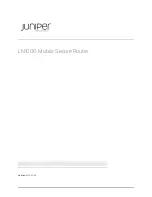
6
Converged Enhanced Ethernet Administrator’s Guide
53-1002163-02
Layer 2 Ethernet overview
1
DRAFT: BROCADE CONFIDENTIAL
Queuing features are described as follows:
•
RED—RED increases link utilization. When multiple inbound traffic streams are switched to the
same outbound port, and some traffic streams send small frames while other traffic streams
send large frames, link utilization will not be able to reach 100 percent. When RED is enabled,
link utilization approaches 100 percent.
•
Classification—Setting user priority.
-
Inbound frames are tagged with the user priority set for the inbound port. The tag is visible
when examining the frames on the outbound port. By default, all frames are tagged to
priority zero.
-
Externally tagged Layer 2 frames—When the port is set to accept externally tagged Layer 2
frames, the user priority is set to the Layer 2 CoS of the inbound frames.
•
Queuing
-
Input queuing—Input queuing optimizes the traffic flow in the following way. Suppose a
CEE port has inbound traffic that is tagged with several priority values, and traffic from
different priority settings is switched to different outbound ports. Some outbound ports
are already congested with background traffic while others are uncongested. With input
queuing, the traffic rate of the traffic streams switched to uncongested ports should
remain high.
-
Output queuing—Output queuing optimizes the traffic flow in the following way. Suppose
that several ports carry inbound traffic with different priority settings. Traffic from all ports
is switched to the same outbound port. If the inbound ports have different traffic rates,
some outbound priority groups will be congested while others can remain uncongested.
With output queuing, the traffic rate of the traffic streams that are uncongested should
remain high.
-
Multicast rate limit—A typical multicast rate limiting example is where several ports carry
multicast inbound traffic that is tagged with several priority values. Traffic with different
priority settings is switched to different outbound ports. The multicast rate limit is set so
that the total multicast traffic rate on output ports is less than the specified set rate limit.
-
Multicast input queuing—A typical multicast input queuing example is where several ports
carry multicast inbound traffic that is tagged with several priority values. Traffic with
different priority settings is switched to different outbound ports. Some outbound ports
are already congested with background traffic while others are uncongested. The traffic
rate of the traffic streams switched to the uncongested ports should remain high. All
outbound ports should carry some multicast frames from all inbound ports. This enables
multicast traffic distribution relative to the set threshold values.
-
Multicast output queuing—A typical multicast output queuing example is where several
ports carry multicast inbound traffic. Each port has a different priority setting. Traffic from
all ports is switched to the same outbound port. If the inbound ports have varying traffic
rates, some outbound priority groups will be congested while others remain uncongested.
The traffic rate of the traffic streams that are uncongested remains high. The outbound
ports should carry some multicast frames from all the inbound ports.
•
Scheduling—A typical example of scheduling policy (using SP0 and SP1 modes) is where ports
0 through 7 carry inbound traffic, each port has a unique priority level, port 0 has priority 0,
port 1 has priority 1, and so on. All traffic is switched to the same outbound port. In SP0 mode,
all ports have DWRR scheduling; therefore, the frames-per-second (FPS) on all ports should
correspond to the DWRR settings. In SP1 mode, priority 7 traffic uses SP; therefore, priority 7
can achieve a higher FPS. Frames from input ports with the same priority level should be
scheduled in a round robin manner to the output port.
















































